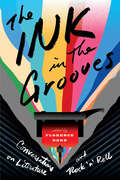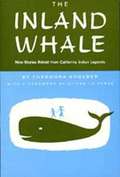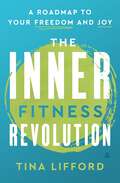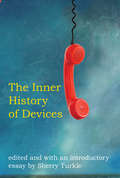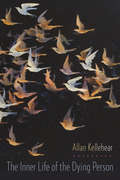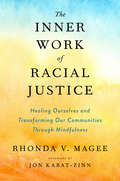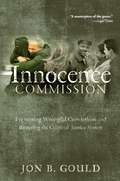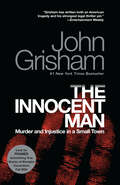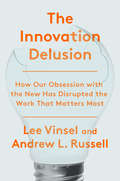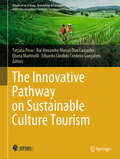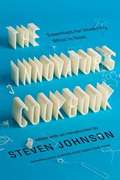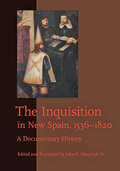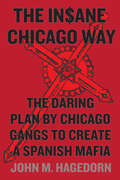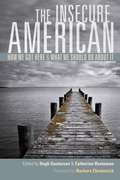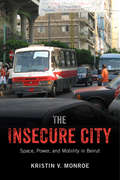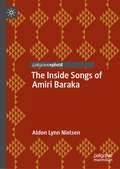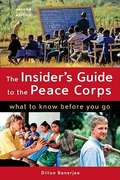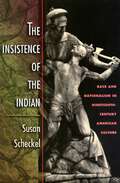- Table View
- List View
The Injustice of Place: Uncovering the Legacy of Poverty in America
by Timothy J. Nelson Kathryn J. Edin H. Luke ShaeferA sweeping and surprising new understanding of extreme poverty in America from the authors of the acclaimed $2.00 a Day: Living on Almost Nothing in America. “This book forces you to see American poverty in a whole new light.” (Matthew Desmond, author of Poverty, by America and Evicted) Three of the nation’s top scholars – known for tackling key mysteries about poverty in America – turn their attention from the country’s poorest people to its poorest places. Based on a fresh, data-driven approach, they discover that America’s most disadvantaged communities are not the big cities that get the most notice. Instead, nearly all are rural. Little if any attention has been paid to these places or to the people who make their lives there.This revelation set in motion a five-year journey across Appalachia, the Cotton and Tobacco Belts of the Deep South, and South Texas. Immersing themselves in these communities, poring over centuries of local history, attending parades and festivals, the authors trace the legacies of the deepest poverty in America—including inequalities shaping people’s health, livelihoods, and upward social mobility for families. Wrung dry by powerful forces and corrupt government officials, the “internal colonies” in these regions were exploited for their resources and then left to collapse. The unfolding revelation in The Injustice of Place is not about what sets these places apart, but about what they have in common—a history of raw, intensive resource extraction and human exploitation. This history and its reverberations demand a reckoning and a commitment to wage a new War on Poverty, with the unrelenting focus on our nation’s places of deepest need.
The Ink in the Grooves: Conversations on Literature and Rock 'n' Roll
by Florence DoreDrop the record needle on any vinyl album in your collection, then read the first pages of that novel you've been meaning to pick up—the reverberations between them will be impossible to miss. Since Dylan went electric, listening to rock 'n' roll has often been a surprisingly literary experience, and contemporary literature is curiously attuned to the history and beat of popular music. In The Ink in the Grooves, Florence Dore brings together a remarkable array of acclaimed novelists, musicians, and music writers to explore the provocatively creative relationship between musical and literary inspiration: the vitality that writers draw from a three-minute blast of guitars and the poetic insights that musicians find in literary works from Shakespeare to Southern Gothic. Together, the essays and interviews in The Ink in the Grooves provide a backstage pass to the creative processes behind some of the most exciting and influential albums and novels of our time.Contributors: Laura Cantrell, Michael Chabon, Roddy Doyle, Bob Dylan, Steve Earle, William Ferris, Dom Flemons, Rhiannon Giddens, Dave Grohl, Peter Guralnick, Amy Helm, Randall Kenan, Jonathan Lethem, Greil Marcus, Rick Moody, Lorrie Moore, the John Prine band (Dave Jacques, Fats Kaplin, Pat McLaughlin, Jason Wilber), Dana Spiotta, John Jeremiah Sullivan, Richard Thompson, Scott Timberg, Daniel Wallace, Colson Whitehead, Lucinda Williams, Warren Zanes.
The Inland Whale: Nine Stories Retold from California Indian Legends
by Theodora KroeberNine tales, selected and retold here by anthropologist and author Theodora Kroeber for the adult general-interest reader. The new foreword by her son, Karl Kroeber, provides context about the author's methods and describes his own personal connection to the stories themselves.
The Inner Fitness Revolution: A Roadmap to Your Freedom and Joy
by Tina LiffordActress and empowerment counselor Tina Lifford guides readers on connecting with their authentic Self—the source of personal power, greater health, and joyful wellbeing—in this follow-up to The Little Book of Big Lies, an inspiring and hands-on guide in the tradition of Yasmine Cheyenne’s The Sugar Jar and Tabitha Brown’s Seen, Loved & Heard.For more than four decades, Tina Lifford has been on a mission. First, in her own life, and now in the world as the founder of The Inner Fitness Project. Her goal? To make “inner fitness” as well understood and actionable as physical fitness.What we know for sure is physical fitness strengthens the body and supports wellness. However, wellness and wellbeing are not the same.Yes, wellness addresses the physical body.Wellbeing stems from the Self inside the body—the health of our thoughts, feelings, and beliefs and the actions and reactions they cause.Now, Tina takes readers into a much deeper and profound understanding of the Inner Fitness Project. This book is about proactively acknowledging and connecting with your inner Self—your source of personal power and inner health and wellbeing. Like physical fitness, inner fitness is an ongoing process of developmentBut exercise does not resolve our internal problems, eliminate feelings of inadequacy or unworthiness, or make us emotionally resilient long-term, nor does exercise administer forgiveness or assuage guilt, help us navigate loss or anxiety, or the thousands of ways we disconnect and drift away from ourselves.Lifford’s latest book aims to help you see your Self in new ways and elevate your relationship with your Self. Whether you are feeling broken, lost, stuck, or overwhelmed, or want to move into a new life chapter, or you are tired of beating yourself up or giving yourself away to everything and everyone in your life, or you want to stop living life as one big competition, soften your hardened heart, and trust life more, every imaginable constriction and problem will change for the better as you practice the art of becoming your whole Self. Every page of The Inner Fitness Revolution supports getting to know yourself and skillfully working with yourself to build a strong, healthy, and resilient inner you that can flourish and thrive despite the challenges and overwhelm that comes with life.Lifford offers 14 Practices that will lead you to a wiser, more whole Self, providing insights and directions for addressing any life situation and feeling empowered and aligned with your Self. The Inner Fitness Revolution will strengthen and help anyone navigate daily life more peacefully and effectively.This is the perfect book to transform your life and allows you to become your best version of yourself.
The Inner History of Devices (The\mit Press Ser.)
by Sherry TurkleMemoir, clinical writings, and ethnography inform new perspectives on the experience of technology; personal stories illuminate how technology enters the inner life.For more than two decades, in such landmark studies as The Second Self and Life on the Screen, Sherry Turkle has challenged our collective imagination with her insights about how technology enters our private worlds. In The Inner History of Devices, she describes her process, an approach that reveals how what we make is woven into our ways of seeing ourselves. She brings together three traditions of listening—that of the memoirist, the clinician, and the ethnographer. Each informs the others to compose an inner history of devices. We read about objects ranging from cell phones and video poker to prosthetic eyes, from Web sites and television to dialysis machines. In an introductory essay, Turkle makes the case for an “intimate ethnography” that challenges conventional wisdom. One personal computer owner tells Turkle: “This computer means everything to me. It's where I put my hope.” Turkle explains that she began that conversation thinking she would learn how people put computers to work. By its end, her question has changed: “What was there about personal computers that offered such deep connection? What did a computer have that offered hope?” The Inner History of Devices teaches us to listen for the answer. In the memoirs, ethnographies, and clinical cases collected in this volume, we read about an American student who comes to terms with her conflicting identities as she contemplates a cell phone she used in Japan (“Tokyo sat trapped inside it”); a troubled patient who uses email both to criticize her therapist and to be reassured by her; a compulsive gambler who does not want to win steadily at video poker because a pattern of losing and winning keeps her more connected to the body of the machine. In these writings, we hear untold stories. We learn that received wisdom never goes far enough.
The Inner Level: How More Equal Societies Reduce Stress, Restore Sanity and Improve Everyone's Well-Being
by Kate Pickett Richard WilkinsonA groundbreaking investigation of how inequality infects our minds and gets under our skinWhy are people more relaxed and at ease with each other in some countries than others? Why do we worry so much about what others think of us and often feel social life is a stressful performance? Why is mental illness three times as common in the USA as in Germany? Why is the American dream more of a reality in Denmark than the USA? What makes child well-being so much worse in some countries than others? As The Inner Level demonstrates, the answer to all these is inequality. In The Spirit Level Richard Wilkinson and Kate Pickett put inequality at the center of public debate by showing conclusively that less equal societies fare worse than more equal ones across everything from education to life expectancy. The Inner Level now explains how inequality affects us individually, altering how we think, feel and behave. It sets out the overwhelming evidence that material inequities have powerful psychological effects: when the gap between rich and poor increases, so does the tendency to define and value ourselves and others in terms of superiority and inferiority. A deep well of data and analysis is drawn upon to empirically show, for example, that low social status leads to elevated levels of stress hormones, and how rates of anxiety, depression and addictions are intimately related to the inequality which makes that status paramount. Wilkinson and Pickett describe how these responses to hierarchies evolved, and why the impacts of inequality on us are so severe. In doing so, they challenge the conception that humans are inescapably competitive and self-interested. They undermine, too, the idea that inequality is the product of "natural" differences in individual ability. This book draws together many of the most urgent problems facing societies today, but it is not just an index of our ills. It demonstrates that societies based on fundamental equalities, sharing and reciprocity generate much higher levels of well-being, and lays out the path towards them.
The Inner Life of the Dying Person
by Allan KellehearThis unique book recounts the experience of facing one's death solely from the dying person's point of view rather than from the perspective of caregivers, survivors, or rescuers. Such unmediated access challenges assumptions about the emotional and spiritual dimensions of dying, showing readers that -- along with suffering, loss, anger, sadness, and fear -- we can also feel courage, love, hope, reminiscence, transcendence, transformation, and even happiness as we die.A work that is at once psychological, sociological, and philosophical, this book brings together testimonies of those dying from terminal illness, old age, sudden injury or trauma, acts of war, and the consequences of natural disasters and terrorism. It also includes statements from individuals who are on death row, in death camps, or planning suicide. Each form of dying addressed highlights an important set of emotions and narratives that often eclipses stereotypical renderings of dying and reflects the numerous contexts in which this journey can occur outside of hospitals, nursing homes, and hospices. Chapters focus on common emotional themes linked to dying, expanding and challenging them through first-person accounts and analyses of relevant academic and clinical literature in psycho-oncology, palliative care, gerontology, military history, anthropology, sociology, cultural and religious studies, poetry, and fiction. The result is an all-encompassing investigation into an experience that will eventually include us all and is more surprising and profound than anyone can imagine.
The Inner Life of the Dying Person
by Allan KellehearThis unique book recounts the experience of facing one's death solely from the dying person's point of view rather than from the perspective of caregivers, survivors, or rescuers. Such unmediated access challenges assumptions about the emotional and spiritual dimensions of dying, showing readers that -- along with suffering, loss, anger, sadness, and fear -- we can also feel courage, love, hope, reminiscence, transcendence, transformation, and even happiness as we die.A work that is at once psychological, sociological, and philosophical, this book brings together testimonies of those dying from terminal illness, old age, sudden injury or trauma, acts of war, and the consequences of natural disasters and terrorism. It also includes statements from individuals who are on death row, in death camps, or planning suicide. Each form of dying addressed highlights an important set of emotions and narratives that often eclipses stereotypical renderings of dying and reflects the numerous contexts in which this journey can occur outside of hospitals, nursing homes, and hospices. Chapters focus on common emotional themes linked to dying, expanding and challenging them through first-person accounts and analyses of relevant academic and clinical literature in psycho-oncology, palliative care, gerontology, military history, anthropology, sociology, cultural and religious studies, poetry, and fiction. The result is an all-encompassing investigation into an experience that will eventually include us all and is more surprising and profound than anyone can imagine.
The Inner Life of the Dying Person (End-of-Life Care: A Series)
by Allan KellehearThis unique book recounts the experience of facing one's death solely from the dying person's point of view rather than from the perspective of caregivers, survivors, or rescuers. Such unmediated access challenges assumptions about the emotional and spiritual dimensions of dying, showing readers that—along with suffering, loss, anger, sadness, and fear—we can also feel courage, love, hope, reminiscence, transcendence, transformation, and even happiness as we die. A work that is at once psychological, sociological, and philosophical, this book brings together testimonies of those dying from terminal illness, old age, sudden injury or trauma, acts of war, and the consequences of natural disasters and terrorism. It also includes statements from individuals who are on death row, in death camps, or planning suicide. Each form of dying addressed highlights an important set of emotions and narratives that often eclipses stereotypical renderings of dying and reflects the numerous contexts in which this journey can occur outside of hospitals, nursing homes, and hospices. Chapters focus on common emotional themes linked to dying, expanding and challenging them through first-person accounts and analyses of relevant academic and clinical literature in psycho-oncology, palliative care, gerontology, military history, anthropology, sociology, cultural and religious studies, poetry, and fiction. The result is an all-encompassing investigation into an experience that will eventually include us all and is more surprising and profound than anyone can imagine.
The Inner Work of Racial Justice: Healing Ourselves and Transforming Our Communities Through Mindfulness
by Rhonda V. MageeAn essential mindfulness and compassion-based approach to confront racial injustice and work towards healing Law professor and mindfulness practitioner Rhonda Magee shows that the work of racial justice begins with ourselves. When conflict and division are everyday realities, our instincts tell us to close ranks, to find the safety of our own tribe, and to blame others. The practice of embodied mindfulness--paying attention to our thoughts, feelings, and physical sensations in an open, nonjudgmental way--increases our emotional resilience, helps us to recognize our unconscious bias, and gives us the space to become less reactive and to choose how we respond to injustice.For victims of injustice, embodied mindfulness calms our fears and helps us to exercise self-compassion. Magee shows us how to slow down and reflect on microaggressions--to hold them with some objectivity and distance--rather than bury unpleasant experiences so they have a cumulative effect over time. She helps us develop the capacity to address the fears and anxieties that would otherwise lead us to re-create patterns of separation and division.It is only by healing from injustices and dissolving our personal barriers to connection that we develop the ability to view others with compassion and to live in community with people of vastly different backgrounds and viewpoints. Incorporating mindfulness exercises, research, and Magee's hard-won insights, The Inner Work of Racial Justice offers a road map to a more peaceful world.
The Inner World of Gatekeeping in Scholarly Publication
by Pejman Habibie Anna Kristina HultgrenThis edited book focuses on the certifiers of scientific knowledge, bringing together experts in a variety of areas in Applied Linguistics to address the complex topic of editing and reviewing in writing for scholarly publication. Drawing on insider perspectives, the authors bring to the fore personal histories, narratives and first-hand accounts of editors and reviewers and help paint a richer and more nuanced picture of the discourses, practices, experiences, success stories, failures, and challenges that frame and shape trajectories of both Anglophone and English as an additional language (EAL) scholars in adjudicating and accrediting academic output. This book will be of interest to researchers, practitioners, supervisors, writing mentors, early-career scholars and graduate students in a variety of fields.
The Innocence Commission: Preventing Wrongful Convictions and Restoring the Criminal Justice System
by Jon B. GouldBeyond Exonerating the Innocent: Author on WAMU RadioConvicted Yet Innocent: The Legal Times ReviewChoice Outstanding Academic Title for 2008DNA testing and advances in forensic science have shaken the foundations of the U.S. criminal justice system. One of the most visible results is the exoneration of inmates who were wrongly convicted and incarcerated, many of them sentenced to death for crimes they did not commit. This has caused a quandary for many states: how can claims of innocence be properly investigated and how can innocent inmates be reliably distinguished from the guilty? In answer, some states have created “innocence commissions” to establish policies and provide legal assistance to the improperly imprisoned.The Innocence Commission describes the creation and first years of the Innocence Commission for Virginia (ICVA), the second innocence commission in the nation and the first to conduct a systematic inquiry into all cases of wrongful conviction. Written by Jon B. Gould, the Chair of the ICVA, who is a professor of justice studies and an attorney, the author focuses on twelve wrongful conviction cases to show how and why wrongful convictions occur, what steps legal and state advocates took to investigate the convictions, how these prisoners were ultimately freed, and what lessons can be learned from their experiences.Gould recounts how a small band of attorneys and other advocates — in Virginia and around the country — have fought wrongful convictions in court, advanced the subject of wrongful convictions in the media, and sought to remedy the issue of wrongful convictions in the political arena. He makes a strong case for the need for Innocence Commissions in every state, showing that not only do Innocence Commissions help to identify weaknesses in the criminal justice system and offer workable improvements, but also protect society by helping to ensure that actual perpetrators are expeditiously identified, arrested, and brought to trial. Everyone has an interest in preventing wrongful convictions, from police officers and prosecutors, who seek the latest and best investigative techniques, to taxpayers, who want an efficient criminal justice system, to suspects who are erroneously pursued and sometimes convicted.Free of legal jargon and written for a general audience, The Innocence Commission is instructive, informative, and highly compelling reading.
The Innocent Man: Murder and Injustice in a Small Town
by John Grisham#1 NEW YORK TIMES BESTSELLER • LOOK FOR THE NETFLIX ORIGINAL DOCUMENTARY SERIES • &“Both an American tragedy and [Grisham&’s] strongest legal thriller yet, all the more gripping because it happens to be true.&”—Entertainment Weekly John Grisham&’s first work of nonfiction: a true crime masterpiece that tells the story of small town justice gone terribly awry. In the Major League draft of 1971, the first player chosen from the state of Oklahoma was Ron Williamson. When he signed with the Oakland A&’s, he said goodbye to his hometown of Ada and left to pursue his dreams of big league glory. Six years later he was back, his dreams broken by a bad arm and bad habits. He began to show signs of mental illness. Unable to keep a job, he moved in with his mother and slept twenty hours a day on her sofa. In 1982, a twenty-one-year-old cocktail waitress in Ada named Debra Sue Carter was raped and murdered, and for five years the police could not solve the crime. For reasons that were never clear, they suspected Ron Williamson and his friend Dennis Fritz. The two were finally arrested in 1987 and charged with capital murder. With no physical evidence, the prosecution&’s case was built on junk science and the testimony of jailhouse snitches and convicts. Dennis Fritz was found guilty and given a life sentence. Ron Williamson was sent to death row. If you believe that in America you are innocent until proven guilty, this book will shock you. If you believe in the death penalty, this book will disturb you. If you believe the criminal justice system is fair, this book will infuriate you.Don&’t miss Framed, John Grisham&’s first work of nonfiction since The Innocent Man, co-authored with Centurion Ministries founder Jim McCloskey.
The Innocent Party
by Aimee Parkison"Aimee Parkison most often begins softly, slowly stripping away each layer of social interaction to get at what is numinous and frightening and necessary about living in the real world. These are stories both about the difficulty and the intense suddenness of human connection, about the profound link that exists between being in love and being alone."-Brian EvensonFrom "The Glass Girl":On certain evenings in dark motels, she could transform her lip into the edge of the bottle, imagining her face was made of amber glass and the men paused above her only to take a drink of breath. Over the years, men drank and drank until there were only two sips left inside. They began sucking the air out of the glass that grew warm in the wrong places because of heat radiating off their hands. The men's breath along with white feathers fell over autumn winds drifting through open windows.In this collection, Kurt Vonnegut Fiction Prize-winner Aimee Parkison's characters struggle to understand what happens when the innocent party becomes the guilty party. With magical realist flair, secrets are aired with dirty laundry, but the stains never come clean. Carol Anshaw writes, "Aimee Parkison offers a distinct new voice to contemporary fiction. Her seductive stories explore childhood as a realm of sorrows, and reveal the afflictions of adults who emerge from this private geography."Aimee Parkison has an MFA from Cornell University. She is associate professor of English at the University of North Carolina at Charlotte, where she teaches creative writing.
The Innocent Party (American Readers Series #17)
by Aimee Parkison"Aimee Parkison most often begins softly, slowly stripping away each layer of social interaction to get at what is numinous and frightening and necessary about living in the real world. These are stories both about the difficulty and the intense suddenness of human connection, about the profound link that exists between being in love and being alone."-Brian EvensonFrom "The Glass Girl":On certain evenings in dark motels, she could transform her lip into the edge of the bottle, imagining her face was made of amber glass and the men paused above her only to take a drink of breath. Over the years, men drank and drank until there were only two sips left inside. They began sucking the air out of the glass that grew warm in the wrong places because of heat radiating off their hands. The men's breath along with white feathers fell over autumn winds drifting through open windows.In this collection, Kurt Vonnegut Fiction Prize–winner Aimee Parkison's characters struggle to understand what happens when the innocent party becomes the guilty party. With magical realist flair, secrets are aired with dirty laundry, but the stains never come clean. Carol Anshaw writes, "Aimee Parkison offers a distinct new voice to contemporary fiction. Her seductive stories explore childhood as a realm of sorrows, and reveal the afflictions of adults who emerge from this private geography."Aimee Parkison has an MFA from Cornell University. She is associate professor of English at the University of North Carolina at Charlotte, where she teaches creative writing.
The Innovation Delusion: How Our Obsession with the New Has Disrupted the Work That Matters Most
by Andrew L. Russell Lee VinselInnovation is the hottest buzzword in business. But what if our obsession with finding the next big thing has distracted us from the work that matters most?&“The most important book I&’ve read in a long time . . . It explains so much about what is wrong with our technology, our economy, and the world, and gives a simple recipe for how to fix it: Focus on understanding what it takes for your products and services to last.&”—Tim O&’Reilly, founder of O&’Reilly Media It&’s hard to avoid innovation these days. Nearly every product gets marketed as being disruptive, whether it&’s genuinely a new invention or just a new toothbrush. But in this manifesto on thestate of American work, historians of technology Lee Vinsel and Andrew L. Russell argue that our way of thinking about and pursuing innovation has made us poorer, less safe, and—ironically—less innovative. Drawing on years of original research and reporting, The Innovation Delusion shows how the ideology of change for its own sake has proved a disaster. Corporations have spent millions hiring chief innovation officers while their core businesses tank. Computer science programs have drilled their students on programming and design, even though theoverwhelming majority of jobs are in IT and maintenance. In countless cities, suburban sprawl has left local governments with loads of deferred repairs that they can&’t afford to fix. And sometimes innovation even kills—like in 2018 when a Miami bridge hailed for its innovative design collapsed onto a highway and killed six people. In this provocative, deeply researched book, Vinsel and Russell tell the story of how we devalued the work that underpins modern life—and, in doing so, wrecked our economy and public infrastructure while lining the pockets of consultants who combine the ego of Silicon Valley with the worst of Wall Street&’s greed. The authors offer a compelling plan for how we can shift our focus away from the pursuit of growth at all costs, and back toward neglected activities like maintenance, care, and upkeep. For anyone concerned by the crumbling state of our roads and bridges or the direction our economy is headed, The Innovation Delusion is a deeply necessary reevaluation of a trend we can still disrupt.
The Innovative Pathway on Sustainable Culture Tourism (Advances in Science, Technology & Innovation)
by Eliana Martinelli Tatjana Pivac Rui Alexandre Marçal Dias Castanho Eduardo Cândido Cordeiro GonçalvesThis book explores how tourism can drive positive change in our world. It explorers at the important connections between sustainability, tourism, and cultural preservation, showing how these elements interact and influence each other. By examining the effects of tourism on local communities and environments, it emphasizes that responsible tourism can truly be a force for good. This book features case studies from countries like Saudi Arabia, Portugal, and China. These examples illustrations show innovative approaches to support local communities while preserving their cultural heritage. Each case study offers a look at how tourism can help enhance social and economic development while also keeping a balance between cultural and environmental needs. This book is for everyone—policymakers, scholars, and industry professionals alike. It brings together ideas from various fields and provides practical strategies for responsible tourism. By inviting readers to rethink tourism&’s role in our increasingly globalized world, it highlights its potential to encourage environmental stewardship and strengthen local identities, ensuring that travel enriches our lives and helps preserve the cultural and natural treasures we hold dear.
The Innovator's Cookbook
by Steven JohnsonEssential reading-and progressive thinking-on the subject of innovation, from the national bestselling author. Steven Johnson, an acknowledged bestselling leader on the subject of innovation, gathers-for a foundational text on the subject of innovation-essays, interviews, and cutting-edge insights by such exciting field leaders as Peter Drucker, Richard Florida, Eric Von Hippel, Dean Keith Simonton, Arthur Koestler, John Seely Brown, and Marshall Berman. Johnson also provides new material from Marisa Mayer of Google, Twitter's Biz Stone and Jack Dorsey, and Ray Ozzie, Microsoft's former Chief Software Architect. With additional commentary by Johnson himself, this book reveals the innovation found in a wide range of fields, including science, technology, energy, transportation, education, art, and sociology, making it vital, fresh, and fascinating reading for our time, and for the future.
The Inquisition in New Spain, 1536–1820: A Documentary History
by John F. Chuchiak IVThe Inquisition! Just the word itself evokes, to the modern reader, endless images of torment, violence, corruption, and intolerance committed in the name of Catholic orthodoxy and societal conformity. But what do most people actually know about the Inquisition, its ministers, its procedures? This systematic, comprehensive look at one of the most important Inquisition tribunals in the New World reveals a surprisingly diverse panorama of actors, events, and ideas that came into contact and conflict in the central arena of religious faith.Edited and annotated by John F. Chuchiak IV, this collection of previously untranslated and unpublished documents from the Holy Office of the Inquisition in New Spain provides a clear understanding of how the Inquisition originated, evolved, and functioned in the colonial Spanish territories of Mexico and northern Central America. The three sections of documents lay out the laws and regulations of the Inquisition, follow examples of its day-to-day operations and procedures, and detail select trial proceedings. Chuchiak’s opening chapter and brief section introductions provide the social, historical, political, and religious background necessary to comprehend the complex and generally misunderstood institutions of the Inquisition and the effect it has had on societal development in modern-day Mexico, Guatemala, El Salvador, Nicaragua, and Honduras. Featuring fifty-eight newly translated documents, meticulous annotations, and trenchant contextual analysis, this documentary history is an indispensable resource for anyone seeking to understand the Inquisition in general and its nearly three-hundred-year reign in the New World in particular.
The Insane Chicago Way: The Daring Plan by Chicago Gangs to Create a Spanish Mafia
by John M. HagedornThe Insane Chicago Way is the untold story of a daring plan by Chicago gangs in the 1990s to create a Spanish Mafia--and why it failed. John M. Hagedorn traces how Chicago Latino gang leaders, following in Al Capone's footsteps, built a sophisticated organization dedicated to organizing crime and reducing violence. His lively stories of extensive cross-neighborhood gang organization, tales of police/gang corruption, and discovery of covert gang connections to Chicago's Mafia challenge conventional wisdom and offer lessons for the control of violence today. The book centers on the secret history of Spanish Growth & Development (SGD)--an organization of Latino gangs founded in 1989 and modeled on the Mafia's nationwide Commission. It also tells a story within a story of the criminal exploits of the C-Note$, the "minor league" team of the Chicago's Mafia (called the "Outfit"), which influenced the direction of SGD. Hagedorn's tale is based on three years of interviews with an Outfit soldier as well as access to SGD's constitution and other secret documents, which he supplements with interviews of key SGD leaders, court records, and newspaper accounts. The result is a stunning, heretofore unknown history of the grand ambitions of Chicago gang leaders that ultimately led to SGD's shocking collapse in a pool of blood on the steps of a gang-organized peace conference. The Insane Chicago Way is a compelling history of the lives and deaths of Chicago gang leaders. At the same time it is a sociological tour de force that warns of the dangers of organized crime while arguing that today's relative disorganization of gangs presents opportunities for intervention and reductions in violence.
The Insecure American: How We Got Here and What We Should Do About It
by Hugh Gusterson Catherine BestemanAmericans are feeling insecure. They are retreating to gated communities in record numbers, fearing for their jobs and their 401(k)s, nervous about their health insurance and their debt levels, worrying about terrorist attacks and immigrants. In this innovative volume, editors Hugh Gusterson and Catherine Besteman gather essays from nineteen leading ethnographers to create a unique portrait of an anxious country and to furnish valuable insights into the nation's possible future. With an incisive foreword by Barbara Ehrenreich, the contributors draw on their deep knowledge of different facets of American life to map the impact of the new economy, the "war on terror," the "war on drugs," racial resentments, a fraying safety net, undocumented immigration, a health care system in crisis, and much more. In laying out a range of views on the forces that unsettle us, The Insecure American demonstrates the singular power of an anthropological perspective for grasping the impact of corporate profit on democratic life, charting the links between policy and vulnerability, and envisioning alternatives to life as an insecure American.
The Insecure City: Space, Power, and Mobility in Beirut
by Kristin V. MonroeFifteen years after the end of a protracted civil and regional war, Beirut broke out in violence once again, forcing residents to contend with many forms of insecurity, amid an often violent political and economic landscape. Providing a picture of what ordinary life is like for urban dwellers surviving sectarian violence, The Insecure City captures the day-to-day experiences of citizens of Beirut moving through a war-torn landscape. While living in Beirut, Kristin Monroe conducted interviews with a diverse group of residents of the city. She found that when people spoke about getting around in Beirut, they were also expressing larger concerns about social, political, and economic life. It was not only violence that threatened Beirut's ordinary residents, but also class dynamics that made life even more precarious. For instance, the installation of checkpoints and the rerouting of traffic--set up for the security of the elite--forced the less fortunate to alter their lives in ways that made them more at risk. Similarly, the ability to pass through security blockades often had to do with an individual's visible markers of class, such as clothing, hairstyle, and type of car. Monroe examines how understandings and practices of spatial mobility in the city reflect social differences, and how such experiences led residents to be bitterly critical of their government. In The Insecure City, Monroe takes urban anthropology in a new and meaningful direction, discussing traffic in the Middle East to show that when people move through Beirut they are experiencing the intersection of citizen and state, of the more and less privileged, and, in general, the city's politically polarized geography.
The Inside Songs of Amiri Baraka (Palgrave Studies in Music and Literature)
by Aldon Lynn NielsenThe Inside Songs of Amiri Baraka examines the full length of Baraka’s discography as a poet recording with musicians as well as his contributions to jazz and R & B, beginning with his earliest studio recordings in 1965 and continuing to the last year of his life, 2014. This recorded history traces his evolution from the era of Beat poetry and “projective verse,” through the period of the Black Arts Movement and cultural nationalism, and on to his commitments to “third world Marxism,” which characterized the last decades of his life. The music enfolding Baraka’s recitations ranges from traditional African drumming, to doo wop, rhythm and blues, soul and the avant garde jazz that was his great love and the subject of so much of his writing, and includes both in-studio sessions and live concert performances. This body of work offers a rare opportunity to think about not only jazz/poetry, but the poet in the recording studio and the relations of text to score.
The Insider's Guide to the Peace Corps: What to Know Before You Go
by Dillon BanerjeeSo, you want to join the Peace Corps . . . If you are interested in joining the Peace Corps, you probably have questions that run the gamut from "What is the application process like?" to "Is the Peace Corps effective as a development agency?" In this updated second edition, former Peace Corps volunteer Dillon Banerjee shares candid facts and insights about the experience in a practical question-and-answer format. With input from recently returned volunteers who served across the globe, this thorough guide presents valuable information including: * What Peace Corps recruiters look for in your application* Items you should--and shouldn't---pack for your two-year trip* Useful gadgets and technology that help volunteers stay connected from far away* Real answers to personal questions about culture shock, safety, dating, homesickness, and more Whether you're thinking of joining or have already been accepted and are preparing to leave, The Insider's Guide to the Peace Corps will help equip you for the unique challenges and rewards of the volunteer experience, regardless of your program area or country assignment. It's essential reading for anyone interested in "the toughest job you'll ever love." From the Trade Paperback edition.
The Insistence of the Indian: Race and Nationalism in Nineteenth-Century American Culture
by Susan ScheckelAmericans' first attempts to forge a national identity coincided with the apparent need to define--and limit--the status and rights of Native Americans. During these early decades of the nineteenth century, the image of the "Indian" circulated throughout popular culture--in the novels of James Fenimore Cooper, plays about Pocahontas, Indian captivity narratives, Black Hawk's autobiography, and visitors' guides to the national capitol. In exploring such sources as well as the political and legal rhetoric of the time, Susan Scheckel argues that the "Indian question" was intertwined with the ways in which Americans viewed their nation's past and envisioned its destiny. She shows how the Indians provided a crucial site of reflection upon national identity. And yet the Indians, by being denied the natural rights upon which the constitutional principles of the United States rested, also challenged American convictions of moral ascendancy and national legitimacy.Scheckel investigates, for example, the Supreme Court's decision on Indian land rights and James Fenimore Cooper's popular frontier romance The Pioneers: both attempted to legitimate American claims to land once owned by Indians and to assuage guilt associated with the violence of conquest by incorporating the Indians in a version of the American political "family." Alternatively, the widely performed Pocahontas plays dealt with the necessity of excluding Indians politically, but also portrayed these original inhabitants as embodying the potential of the continent itself. Such examples illustrate a gap between principles and practice. It is from this gap, according to the author, that the nation emerged, not as a coherent idea or a realist narrative, but as an ongoing performance that continues to play out, without resolution, fundamental ambivalences of American national identity.

